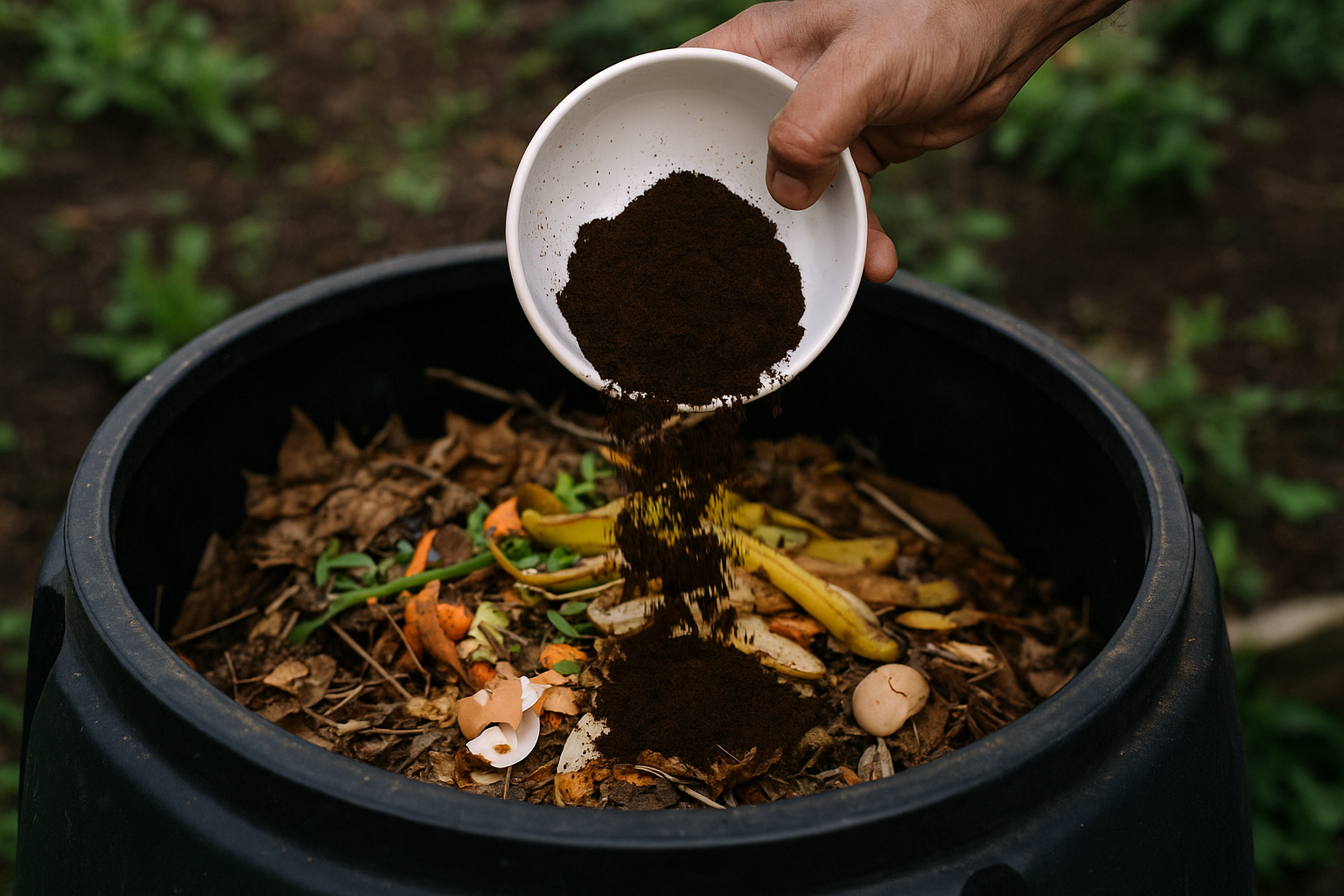Composting is one of the most practical and impactful steps you can take to live more sustainably. While most people think of composting food scraps or yard waste, coffee grounds are often overlooked as a powerful addition to your compost pile.
Whether you’re a seasoned gardener or a curious beginner, understanding how to compost with coffee grounds can improve soil health, reduce landfill waste, and make your coffee habit even greener.
In this guide, you’ll learn how coffee grounds contribute to composting, how to use them correctly, and what to avoid.
Why Compost Coffee Grounds?
Used coffee grounds are rich in nitrogen—a key component of any healthy compost system. When combined with carbon-rich materials (known as “browns”), coffee grounds help fuel the microbial activity necessary for breaking down organic matter.
Some benefits of composting coffee grounds include:
- Improving soil structure and fertility
- Reducing methane emissions from landfills
- Cutting down household waste
- Saving money on fertilizers
- Enhancing plant growth naturally
In short, you’re turning waste into a resource—an action that aligns with the core of environmental sustainability.
Understanding the Basics of Composting
Before we get into coffee grounds specifically, here’s a quick overview of how composting works. Successful composting requires a balance between:
- Greens (nitrogen-rich materials): Coffee grounds, fruit peels, vegetable scraps, grass clippings
- Browns (carbon-rich materials): Dry leaves, cardboard, newspaper, wood shavings
The ideal carbon-to-nitrogen ratio is about 30:1, which helps bacteria and fungi break down the materials efficiently.
You also need:
- Air: Regular turning helps oxygen reach the microbes
- Moisture: The pile should feel like a wrung-out sponge
- Time: Depending on conditions, compost is ready in 2–6 months
Coffee grounds are considered greens, even though they’re brown in color.
How to Add Coffee Grounds to Compost
Used coffee grounds can go directly into your compost bin or pile, but there are a few best practices to keep in mind.
1. Mix, Don’t Pile:
Avoid dumping large amounts of coffee grounds in one spot. They can compact and form a dense layer that restricts airflow and slows decomposition. Instead, mix them evenly with browns like leaves or shredded paper.
2. Keep the Filter:
Paper coffee filters are usually compostable—just make sure they’re unbleached and free from plastic. Toss them in along with the grounds for added carbon.
3. Use in Moderation:
While coffee grounds are great for compost, they’re potent. Keep them under 20% of your compost pile’s total volume to avoid creating overly acidic conditions.
4. Add Kitchen Scraps:
Coffee grounds pair well with other food waste like fruit peels, veggie scraps, and eggshells. Just balance with enough browns to prevent odors and pests.
5. Turn the Pile Regularly:
Mixing the pile helps incorporate the grounds, distributes moisture, and introduces oxygen—all essential for healthy composting.
Worm Composting with Coffee Grounds
If you use a vermicomposting system (composting with worms), coffee grounds can still be a valuable addition. However, moderation is even more important here.
Too many grounds can make the bedding too acidic for the worms. Add small amounts at a time and monitor your worm bin’s smell and worm activity. Some tips:
- Let the grounds dry before adding to reduce acidity
- Mix with shredded newspaper or cardboard
- Don’t overload your bin with fresh coffee grounds all at once
If done right, your worms will love the grounds—and you’ll have high-quality castings to feed your plants.
Using Coffee Grounds as Direct Mulch
Aside from composting, some gardeners use coffee grounds directly as mulch. While this can be effective, it should be done carefully.
Pros:
- Adds nitrogen to the soil
- Suppresses weeds
- Improves soil texture over time
Cons:
- Can compact and form a crust
- May temporarily acidify soil
- Could inhibit seed germination if applied too thickly
To use coffee grounds as mulch:
- Mix with other organic material (like leaves or straw)
- Apply a thin, even layer around plants—avoid direct contact with stems
- Water lightly after applying
This method works particularly well around acid-loving plants like blueberries, azaleas, and hydrangeas.
Coffee Grounds in Compost Tea
Some gardeners brew compost tea—a liquid fertilizer made from steeping compost in water. Coffee grounds can be added to this mix for an extra nitrogen boost.
Basic method:
- Mix one part compost (including coffee grounds) with five parts water
- Let steep for 24–48 hours
- Strain and pour around plants or spray on leaves
This liquid can help feed plants and beneficial soil organisms, especially during growing seasons.
Common Myths About Coffee Grounds in Compost
Myth 1: Coffee grounds are too acidic for compost.
Truth: Used grounds are close to neutral in pH. The brewing process removes most of the acidity.
Myth 2: Coffee kills worms.
Truth: Worms can digest coffee grounds in moderation. Just avoid large, compacted layers.
Myth 3: Coffee attracts pests.
Truth: Grounds alone don’t attract pests, but when mixed with other food scraps, a poorly balanced compost pile might. Cover fresh additions with browns.
Myth 4: Coffee grounds cause mold.
Truth: Like any organic material, grounds can mold if stored wet. In a compost pile, mold is part of the decomposition process.
Benefits for the Environment
By composting coffee grounds instead of sending them to a landfill, you’re helping combat one of the biggest issues in modern waste management: methane emissions.
Organic materials in landfills break down anaerobically (without oxygen), producing methane—a greenhouse gas 25 times more potent than carbon dioxide. Composting introduces oxygen and turns waste into a resource instead.
Plus, the resulting compost improves soil health, reduces the need for chemical fertilizers, and supports healthy food systems.
Getting Started: Tips for Beginners
New to composting? Here’s a simple way to get started with coffee grounds:
- Choose a composting method: backyard bin, pile, tumbler, or worm bin
- Collect your coffee grounds daily in a separate container
- Store a pile of dry browns nearby (leaves, shredded paper, sawdust)
- Add equal amounts of browns and greens to your compost
- Turn the pile every 1–2 weeks
- Watch it break down and enjoy the process!
If you live in an apartment or don’t have a garden, check if your city has a compost collection program. Some local farmers’ markets also accept compostable materials.
Final Thoughts: From Waste to Worth
Coffee grounds are a valuable and abundant waste product that most of us generate daily. Instead of sending them to the trash, composting gives these grounds new life—improving soil, reducing emissions, and helping you live more sustainably.
By taking a few simple steps, you can turn your morning ritual into an act of environmental care. It’s a small habit with a big payoff—for your plants, your planet, and your peace of mind.

